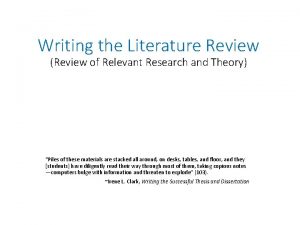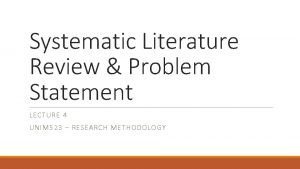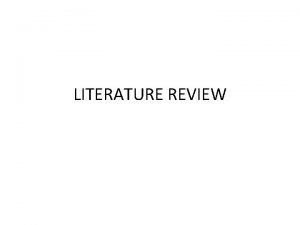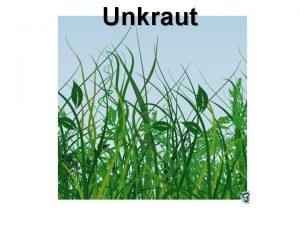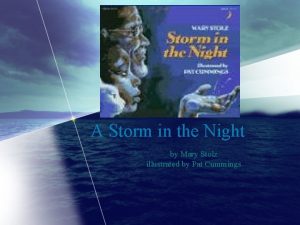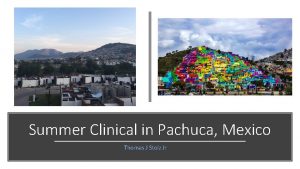Literature Review Stolz D C S A Rutledge















- Slides: 15

Literature Review: Stolz, D. C. , S. A. Rutledge, and J. R. Pierce (2015), Simultaneous influences of thermodynamics and aerosols on deep convection and lightning in the tropics, J. Geophys. Res. Atmos. , 120, doi: 10. 1002/2014 JD 023033. Kyle Hilburn AT 740 April 16, 2019 1

Overview Subject: – – – • Thermodynamics Aerosols Deep Convection Lightning Tropics Datasets: – TRMM CF (PR + LIS) • 2004 -2011 • Version 7 – GEOS-Chem-TOMAS • GFED 3 biomass burning inventory • GEOS-Chem transport • TOMAS aerosol microphysics module – ERAi • Thermodynamic environment • Inflow swath to CFs • Main conclusions: – Higher CCN and NCAPE lead to stronger convection – WCD modules relationship High Flash Density 10, 000 N 40 (cm-3) • WCD 4. 5 -5 km 1, 000 100 WCD 2 -3. 5 km 10 0. 1 0. 2 0. 3 NCAPE (J kg-1 m-1) My cartoon summary of the paper, based on Figure 3 High Flash Density > 0. 005 fl min-1 km-2 High FD area shifts right and gets smaller with increasing WCD Median WCD is 4. 2 km • Inverse: greater TLD and H 30 with shallower WCD 2

Thermodynamic Hypothesis • Variability in lightning and convective intensity over continental and oceanic regions of tropics can be explained by differences in thermodynamic instability – Rutledge et al. 1992; Williams et al. 1992, 2002; Williams and Stanfill 2002; Williams and Sátori 2004 • Tropical land surfaces respond strongly to solar radiation; more energetic parcels ascend through deep BL and have less dilution via entrainment • Would expect more robust mixed phase microphysics and NIC over land 3

Aerosol Hypothesis • Number of CCN significantly influences microphysical properties and vertical development – Rosenfeld and Lensky 1998; Rosenfeld 1999; Rosenfeld et al. 2008; … and many more • Aerosol-induced convective invigoration – High CCN environment hinders collision-coalescence warm rain process • Less offloading of condensate – More cloud water transported to mixed phase region – Latent heat release provides increased buoyancy and greater charge separation 4

Warm Cloud Depth Hypothesis • WCD: distance between LCL and FL • WCD determines duration of ascent through warm phase region and time for collisioncoalescence to operate • Deeper WCD: cloud liquid lost before reaching mixed phase region • Shallow WCD: more cloud liquid reaches mixed phase region • Very shallow WCD (outside tropics): time for aerosols to impact collision-coalescence too short to see sensitivity to aerosols 5

Spatial Patterns Cloud Features Lightning Producing CFs All cloud features looks like precip map Many LPCFs but low FD over Amazon ”Green Ocean” Good correlation between H 30 and FD …. Price and Rind not looking so bad! S. Hem. FD hotspots for southern S. Am. and Africa, Australia with few LPCFs - high flash rate storms Aerosol ocean land H 30 FD CAPE Aerosol WCD NCAPE about same for ocean/land Strong mean spatial correlation between N 40 and FD High WCD over Amazon, central Africa; lower over southern S. Am. and Africa, SE US, and Australia 6

Lightning/Height vs NCAPE, N 40, and WCD • Results for lightning (left) and H 30 (above) similar • Highest TLD for N 40 > 1000 cm-3 and NCAPE > 0. 15 J kg-1 m-1 • High FD retreats to highest NCAPE and N 40 at deep WCD 7

Land vs Ocean • Same WCD effect over land ocean • Greater FD (left) and H 30 (above) over land than ocean 8

Partial Sensitivities • TLD has greater variability with N 40 than NCAPE (except over oceans) • Slope with NCAPE roughly constant, but variable for N 40 • Steepest slope for shallow WCD • Slope negative for low NCAPE, deep WCD, and high N 40 9

Shallow vs Deep Differences • Difference for shallow minus deep • Differences mostly > 0 • Maximum increases for higher NCAPE and higher N 40 10

Lightning/Reflectivity versus Aerosol • FD increases with H 30 (below) • FD greater for greater N 40 • Sensitivity decreases with decreasing N 40 • VPRR vs CAPE, WCD, N 40 (right) • Increase in reflectivity at given altitude for larger N 40 • Largest change in VPRR for shallower WCD 11

Summary and Conclusions • Highest flash rates (and highest 30 d. BZ echo heights) associated with combination of high NCAPE, high N 40, and shallower WCD • Reflectivity in mixed phase region 5. 0 -5. 6 d. B greater in polluted environment • Merged hypothesis for simultaneous roles of thermodynamics and aerosols influencing deep convection in tropics – Modulated by warm cloud depth 12

BACKUP SLIDES 13

Land/Ocean Cloud/Lightning Histograms N 40 different land/ocean, but NCAPE and WCD about the same 14

Tables 15
 Erika stolz
Erika stolz Chapter review motion part a vocabulary review answer key
Chapter review motion part a vocabulary review answer key Ap gov review final exam review
Ap gov review final exam review Narrative review vs systematic review
Narrative review vs systematic review Narrative review vs systematic review
Narrative review vs systematic review Narrative review vs systematic review
Narrative review vs systematic review Purpose of review of related literature
Purpose of review of related literature 8 importance of literature review
8 importance of literature review Order literature review
Order literature review Review adalah
Review adalah What is the inclusion and exclusion criteria in research
What is the inclusion and exclusion criteria in research Literature review gantt chart
Literature review gantt chart Scribbr
Scribbr Theoretical framework in literature review
Theoretical framework in literature review Na in lr
Na in lr Literature review on enterprise risk management
Literature review on enterprise risk management






